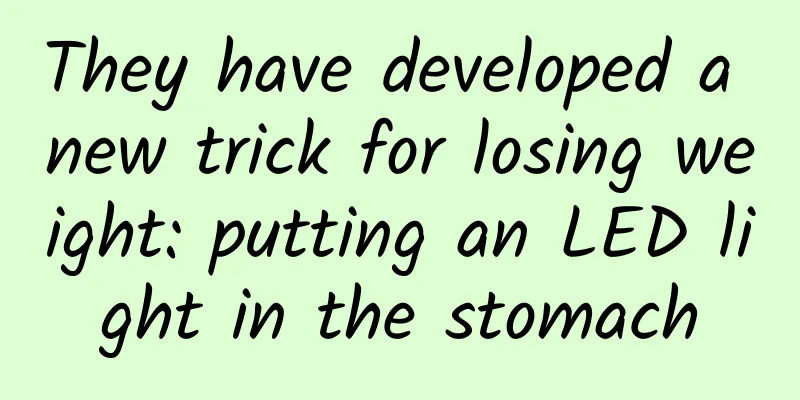They have developed a new trick for losing weight: putting an LED light in the stomach

|
Recently, Tadpole often discusses the topic of weight loss with everyone. After all, obesity is a major problem that troubles girls, and the season of showing off your body is coming soon. So, is there any magic tool for weight loss? It is said that light can help you lose weight. Have you heard of this? A new way to cure obesity? A study shows that hunger can be suppressed using optogenetics. I know genetics and I've heard of optics, but what is optogenetics? How is it related to weight loss? Let's take a look. Optogenetics was first proposed by scientist Karl Deisseroth in 2006[3]. Subsequently, Karl Deisseroth and Edward Boyden pioneered the era of optogenetics. Simply put, optogenetics is a genetic technology that combines optics, genetics, and bioengineering to use light of a certain wavelength to precisely control cells or biological structures[4]. The basic principle is this: when not stimulated, there is a potential difference between the inside and outside of the neuron membrane, which is negative inside and positive outside, that is, the resting potential. The resting potential is formed due to the different permeability of the cell membrane to different ions and the uneven distribution of ions on both sides of the membrane. Using biological means, the photosensitive channel protein genes are transferred into specific types of cells in the nervous system. The photosensitive channel proteins expressed by these genes are located on the cell membrane. Under the irradiation of light of different wavelengths, the photosensitive ion channel proteins allow cations or anions to pass selectively, causing changes in the cell membrane potential, thereby controlling the excitation or inhibition of the cell. The specific light-sensitive channel protein gene was transferred into the mouse nerve cells in the picture. Using optogenetics, blue light can be used to successfully activate neurons and wake up sleepy mice. Image source: science So how can we use optogenetics to lose weight? We know that patients with serious health problems due to obesity often choose gastric bypass surgery, which is a complicated and dangerous procedure that changes the size of the stomach and the path of the small intestine to achieve weight loss. Optogenetics also intends to make use of this approach, attempting to achieve the goal of weight loss through simple surgical implantation[5]. New idea for weight loss using optogenetics. Image source: Nature Communications The researchers used AAV virus as a vector to transfer a specific activated light-sensitive channel protein gene to specific vagus nerve endings in the stomach, and inserted a miniature LED device into the stomach to suppress hunger by regulating LED light. Studies have shown that this method can produce a feeling of fullness, which means that even if you don’t eat, you won’t feel hungry (isn’t it great), thereby helping users control their appetite and achieve the goal of losing weight (have you suddenly got the essence of this research?). Of course, the experiment is still in the research stage. Let us wait and see whether this research can be put into use in the future. In fact, for most obese people, they should still choose the mainstream weight loss method: control your diet and move your legs. The above-mentioned optogenetics weight loss technique is mainly aimed at pathological obesity. References: [1] Zuo Xiaocong, Xiong Yan, Yuan Hong. Theories and evaluation of the causes of obesity[J]. Medicine and Philosophy: B, 2008, 29(8): P.52-54. [2] Tirosh A, Tuncman G, Calay ES, et al. Intercellular Transmission of Hepatic ER Stress in Obesity Disrupts Systemic Metabolism[J]. Cell Metab, 2020. [3] Deisseroth K, Feng G, Majewska AK, et al. Next-generation optical technologies for illuminating genetically targeted brain circuits[J]. J Neurosci, 2006, 26(41): 10380-10386. [4] Guo Xuantong, Zhang Chunbo. Research progress of optogenetics technology[J]. Chinese Journal of Biotechnology, 2019. [5] Kim WS, Hong S, Gamero M, et al. Organ-specific, multimodal, wireless optoelectronics for high-throughput phenotyping of peripheral neural pathways[J]. Nat Commun, 2021, 12(1): 157. END Review expert: Ji Shi, life field observer Editor/Heart and Paper |
>>: The invisible killer - Candida albicans
Recommend
Is it no longer popular to promote products through internet celebrities? Brand self-broadcasting becomes a new trend
Currently, brand self-broadcasting has become a n...
How to register for WeChat Video Account? How to apply for internal testing of WeChat Video Account?
Before we knew it, someone posted a message on We...
Basic knowledge of POS machines, understand POS machine knowledge
The POS machine used always jumps code, which caus...
Meituan's new challenge: Tier 3 and 4 markets are impacted, and many O2O giants are involved
As a survivor of the group buying war, Meituan ha...
Hu Q&A丨Why do nuclear submarines run so fast?
Where do nuclear submarines run faster? First, ru...
"Hitting a tree can improve your health"? Wrong! Be careful of serious problems
In the park in the morning Have you ever seen suc...
360 special-purpose phone official Weibo suddenly updated: Will the new phone be launched in May this year?
The long-silent 360 official Weibo account sudden...
Learn from Didi to provide subsidies to attract users? But you don’t know the essence of its subsidies!
The article is a sharing of operational experienc...
What did Baidu do with its 7 billion research funds?
[[128328]] It is said that this is Baidu's in...
Great Wall Motors' Haomo Zhixing received hundreds of millions of yuan in financing in the first round and will achieve autonomous driving step by step
Great Wall Motors Momentum Intelligent Driving Te...
Is high blood lipid caused by eating too much meat and fish? Will eating more vegetarian food help?
Many people have found after physical examination...
Traffic analysis in fission growth mode
Fission growth has always played an important rol...
How many steps are there to grow potatoes in space? Botanists answer...
On October 12, 2024, Shi Jun, a Ph.D. in botany a...
The road to "customized marketing" for online education in 2020
The battle for customer acquisition in online edu...
How to make users addicted to your product? These 4 steps are required
What would happen if users fell in love with prod...









